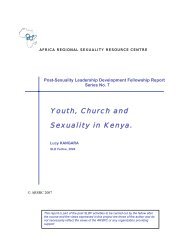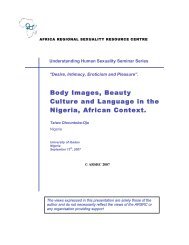Sexuality in Media: Emerging Issues in Africa - Africa Regional ...
Sexuality in Media: Emerging Issues in Africa - Africa Regional ...
Sexuality in Media: Emerging Issues in Africa - Africa Regional ...
You also want an ePaper? Increase the reach of your titles
YUMPU automatically turns print PDFs into web optimized ePapers that Google loves.
<strong>Sexuality</strong> <strong>in</strong> the <strong>Media</strong>: Emerg<strong>in</strong>g <strong>Issues</strong> <strong>in</strong> <strong>Africa</strong><br />
Table (2) Percent distribution of the participants who are exposed to the pr<strong>in</strong>t<br />
media by their background characteristics.<br />
Background characteristics<br />
Age:<br />
15-19<br />
20-24<br />
25-29<br />
30-34<br />
35-39<br />
40-44<br />
45-49<br />
Residence:<br />
Urban<br />
Rural<br />
Education:<br />
No Education<br />
Some Primary<br />
Primary complete/some secondary<br />
Secondary Complete/higher<br />
Work Status:<br />
Work<strong>in</strong>g for Cash<br />
Not Work<strong>in</strong>g for Cash<br />
Percent of those who<br />
are exposed to written media<br />
10.0<br />
17.0<br />
20.6<br />
25.5<br />
23.4<br />
23.8<br />
16.8<br />
35.0<br />
10.4<br />
0.8<br />
4.2<br />
20.2<br />
48.3<br />
48.8<br />
15.6<br />
Source: Adapted from EDHS (2003) table 1.11 page 14<br />
However, exposure to the media does not mean that it is the preferred source of<br />
<strong>in</strong>formation for a health issue. For <strong>in</strong>stance, though the percentage of those who<br />
are exposed to the pr<strong>in</strong>t media is high (about 21%), it is not considered as a ma<strong>in</strong><br />
source of <strong>in</strong>formation for reproductive health and family plann<strong>in</strong>g issues. The<br />
EDHS (2003) listed the sources from which women last saw/heard about<br />
HIV/AIDS as follows:<br />
• 95.5% from T.V.<br />
• 0.7% from other media sources <strong>in</strong>clud<strong>in</strong>g newspapers<br />
• 0.7% from a health provider.<br />
Regard<strong>in</strong>g the safe <strong>in</strong>jection practice:<br />
• 56.7% from T.V.<br />
• 1.7% from other media sources <strong>in</strong>clud<strong>in</strong>g newspapers<br />
• 27.0% from a health provider.<br />
Regard<strong>in</strong>g communication about female circumcision:<br />
• 70.7% from T.V.<br />
• 0.2% from Radio<br />
• 0.3% from newspapers/magaz<strong>in</strong>es<br />
Regard<strong>in</strong>g safe motherhood:<br />
• 72.7% from T.V.<br />
• 36.8% from Radio<br />
• 20.4% from newspapers/magaz<strong>in</strong>es.<br />
Regard<strong>in</strong>g family Plann<strong>in</strong>g:<br />
• 87.6% from T.V.<br />
• 0.2% from Radio<br />
• 0.1 from newspapers/magaz<strong>in</strong>es (EDHS, 2003).<br />
Pr<strong>in</strong>t <strong>Media</strong> Coverage Of <strong>Sexuality</strong> <strong>Issues</strong> <strong>in</strong> Egypt<br />
The Coverage of <strong>Sexuality</strong> <strong>in</strong> the Pr<strong>in</strong>t <strong>Media</strong><br />
The coverage of reproductive health and sexuality <strong>in</strong> the pr<strong>in</strong>t media has<br />
improved tremendously s<strong>in</strong>ce 1998. In March, 1998 the Population Council<br />
<strong>in</strong> Cairo organized a roundtable discussion to present key f<strong>in</strong>d<strong>in</strong>gs of<br />
completed research to selected journalists associated with widely read Arabic<br />
newspapers and magaz<strong>in</strong>es. Topics covered <strong>in</strong> this session <strong>in</strong>cluded male<br />
<strong>in</strong>volvement, post abortion care, female genital cutt<strong>in</strong>g (FGC/FGM), and<br />
adolescents. Two outcomes resulted from this roundtable. First, participants<br />
wrote several articles and <strong>in</strong>-depth news reports about the issues presented.<br />
Secondly, this session lead to an ongo<strong>in</strong>g dialogue with members of the group<br />
of journalists (Hegazi and Khalifa, 2000). Follow<strong>in</strong>g this success, the<br />
POLICY and FRONTIERS Projects <strong>in</strong> Egypt jo<strong>in</strong>tly organized a session on<br />
maternal health services <strong>in</strong> collaboration with the Population and Family<br />
Plann<strong>in</strong>g Sector of the M<strong>in</strong>istry of Health and Population. The session resulted<br />
<strong>in</strong> the production of several press articles and lengthy news reports (Hegazi<br />
and Khalifa, 2000). Based on these experiments and <strong>in</strong> order to widen media<br />
coverage of critical reproductive health issues <strong>in</strong> a more systematic manner, an<br />
<strong>in</strong>tervention based project was designed and was based on three elements:






